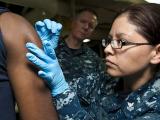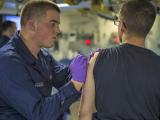Editor's note: This article was revised Aug 15, 2005, to include additional information regarding earlier related research.
Aug 11, 2005 (CIDRAP News) Researchers have identified three people whose previous smallpox vaccinations may have protected them from monkeypox during the 2003 US outbreak. Despite exposure to monkeypox-infected prairie dogs in Wisconsin, these three subjects did not show any clinical signs of the disease. New laboratory results suggest that they developed antibodies to the monkeypox virus but never developed the disease because of their prior smallpox vaccinations.
Vaccina, the virus used in smallpox vaccines, and the monkeypox virus are closely related members of the viral orthopox family. The authors of a Nature Medicine report published online Aug 7 suggest that antibodies to vaccinia were sufficiently cross-reactive to protect these people from monkeypox. The study's senior author, Mark Slifka, told the Associated Press that their findings could be beneficial in the event of a smallpox bioterrorist attack.
Prior to 1972, approximately 50% of people in the United States received smallpox vaccinations. In 1979, smallpox was declared eradicated, and currently the only known stocks of the virus are at the Centers for Disease Control and Prevention in Atlanta, Georgia, and the Russian State Centre for Research on Virology and Biotechnology, Koltsovo, Novosibirsk Region, Russian Federation. However, some experts suspect that additional stocks may still exist and could be used in a bioterrorist attack.
Assessing the level of immunity in the US population has been a subject of great interest in recent years. A prior study by Slifka's group measured antibody levels in people years after smallpox vaccination and found that antibodies and T-cell responses may persist for as long as 75 years after vaccination. However, some experts found flaws with the authors' interpretation of their results (see links below), and it has so far proven impossible to verify whether the levels of antibodies measured in vaccinated people would protect them in the case of smallpox exposure. The recent monkeypox outbreak provided a rare opportunity to study the persistence of immunity, as antibodies against vaccinia are cross-reactive to monkeypox.
In the new article, the authors outline three methods of detecting monkeypox and vaccinia immune response. They first examined whole, killed vaccinia and monkeypox cells using enzyme-linked immunosorbent assay (ELISA) testing. With this technique, they found that people who had never received the smallpox vaccine had very low (<100 ELISA units [EU]) antibody levels. People who received the vaccine but were not exposed to monkeypox had higher vaccinia titers (100-4,400 EU) and a monkeypox-vaccinia antibody ratio of 1:1, indicating only the effects of antibody cross-reactivity rather than monkeypox-specific antibodies. Finally, people infected with monkeypox but never vaccinated against smallpox had high levels of monkeypox antibodies compared with vaccinia antibodies.
Of the eight people who were exposed to both vaccinia (though a prior smallpox vaccination) and monkeypox (through contact with infected prairie dogs), three never developed any clinical symptoms of the disease, though they had high antibody levels indicative of recent orthopoxvirus exposure. These results raised the possibility of persistent immunity following smallpox vaccination in the distant past. Other possibilities for the scenario exist as well, as evidenced by a recent study regarding possible low virulence of the monkeypox virus in the 2003 US outbreak (see below).
Because current laboratory techniques cannot distinguish readily between monkeypox and vaccinia antibodies, the authors developed a second ELISA test using specific protein fragments. The compared the genomes of the monkeypox and vaccinia viruses and selected proteins present only in monkeypox. Several of these gene products showed promise as potential diagnostic tools for monkeypox diagnosis.
Finally, the study's authors described their use of a T-cell quantification method for diagnosis. T cells that retain memory of a specific virus will release antiviral factors (interferon-gamma and tumor necrosis factoralpha) upon reexposure to the virus. By immunostaining against these factors, it is possible to count relative numbers of CD4+ and CD8+ T cells that specifically react to the tested virus. The researchers measured the responses of T cells isolated from vaccinia-immune, monkeypox-infected, and naive subjects. They found that CD8+ cell counts could distinguish between people recently exposed to orthopoxviruses (through monkeypox infection) and those with old exposure from a vaccination or no exposure at all. However, one of the three people who developed no clinical monkeypox symptoms fell below the threshold for recent exposure by this test.
The authors highlighted three important ramifications of their findings. First, they described how "our diagnostic approaches confirmed monkeypox infection in individuals whose infections were previously listed as probable or suspect." Though these people showed clinically indicative signs of the disease, their serologic testing came back negative or equivocal. Retrospective testing using whole-cell ELISA, T-cell immunostaining, and/or peptide ELISA was able to confirm the exposure.
Second, they point to the utility of the new laboratory techniques in diagnosing monkeypox infections in Africa. They speculated that the techniques presented in the article could ease the problem of diagnosis in an area where outbreaks are frequent, saying "An advantage of using the immunologic assays described here is that a positive diagnosis can be made retrospectively because of persisting immunity."
Finally, the authors emphasized the importance of this further evidence of persistent smallpox immunity in the US population over age 35. "The main (albeit speculative) point of this current study, " the authors emphasized, "is that our findings . . . show that some level of protective immunity probably exists in contemporary subjects who have received smallpox vaccination in the distant past." Such immunity could prove critical in limiting fatalities from an intentional release of smallpox.
The study was funded by the National Institutes of Health and the Oregon National Primate Research Center.
Hammarlund E, Lewis MW, Carter SV, et al. Multiple diagnostic techniques identify previously vaccinated individuals with protective immunity against monkeypox. Nat Med 2005 (published online Aug 7) [Abstract]
See also:
Jul 10, 2003, CIDRAP News story on monkeypox outbreak
Jul 22, 2005, CIDRAP News story on virulence of strain in 2003 US monkeypox outbreak
Aug 19, 2003, CIDRAP News story on earlier research by Slifka group [includes link to abstract of study, which was published online Aug 17]
Aug 21, 2003, CIDRAP News story on critique of Aug 17, 2003, study
Sep 12, 2003, CIDRAP News story in which Slifka et al rebut critique above


















